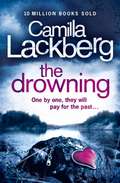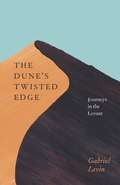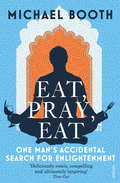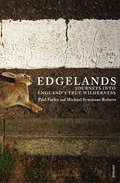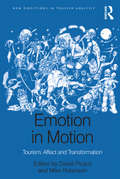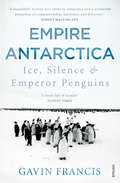- Table View
- List View
DOT symbols: coat check, baggage lockers (UEB Contracted)
by RnibOn this page there are two US Department of Transport (DOT) pictograms used for signage and travel information: a coat check symbol and a baggage lockers pictogram. There is a locator dot shown, which will be at the top left of the page when the image is the correct way up. The coat check symbol is at the top of the page. It is a stylised image of a coat hanger with its hook at the top of the image. The baggage lockers pictogram is at the bottom of the page. At the top of the pictogram is a key with its blade to the right and below this is a rectangle representing a locker. This has a stylised image of a suitcase inside it.
DOT symbols: coat check, baggage lockers (UEB Uncontracted)
by RnibOn this page there are two US Department of Transport (DOT) pictograms used for signage and travel information: a coat check symbol and a baggage lockers pictogram. There is a locator dot shown, which will be at the top left of the page when the image is the correct way up. The coat check symbol is at the top of the page. It is a stylised image of a coat hanger with its hook at the top of the image. The baggage lockers pictogram is at the bottom of the page. At the top of the pictogram is a key with its blade to the right and below this is a rectangle representing a locker. This has a stylised image of a suitcase inside it.
DOT symbols: coat check, baggage lockers (Large Print)
by RnibOn this page there are two US Department of Transport (DOT) pictograms used for signage and travel information: a coat check symbol and a baggage lockers pictogram. There is a locator dot shown, which will be at the top left of the page when the image is the correct way up. The coat check symbol is at the top of the page. It is a stylised image of a coat hanger with its hook at the top of the image. The baggage lockers pictogram is at the bottom of the page. At the top of the pictogram is a key with its blade to the right and below this is a rectangle representing a locker. This has a stylised image of a suitcase inside it.
DOT symbols: heliport, taxi (UEB Contracted)
by RnibOn this page there are two US Department of Transport (DOT) pictograms used for signage and travel information: a heliport pictogram and a taxi pictogram. There is a locator dot shown, which will be at the top left of the page when the image is the correct way up. The heliport pictogram is at the top of the page. It shows a stylised image of a helicopter seen from the side with its front to the right. At the top of the image is the main rotor and from left to right you can find the tail rotor, the tail boom and the cockpit with three windows. At the bottom of the image, you can find one of the skids that the helicopter lands on. The taxi pictogram is at the bottom of the page. It is a stylised image of a taxi seen from the front. At the top of the taxi image is its taxi sign and below this are the front window, two headlights and two front wheels.
DOT symbols: hotel information, air transportation (UEB Contracted)
by RnibOn this page there are two US Department of Transport (DOT) pictograms used for signage and travel information: a hotel information pictogram and an air transportation pictogram. There is a locator dot shown, which will be at the top left of the page when the image is the correct way up. The hotel information pictogram is in the top left of the page. It consists of a print question mark in a circle with a stylised image of a person in bed down the page. The person and bed are seen from the side. The headboard is to the left. To the right of this is the persons head resting on one of their bent arms. To the right is the bedcover and foot of the bed. The beds legs are at the bottom of the image. The air transportation pictogram is a silhouette of a passenger aircraft at the bottom right of the page. It is seen from above with its nose at the top and its wings and tail plane extending to the left and right.
DOT symbols: hotel information, air transportation (Large Print)
by RnibOn this page there are two US Department of Transport (DOT) pictograms used for signage and travel information: a hotel information pictogram and an air transportation pictogram. There is a locator dot shown, which will be at the top left of the page when the image is the correct way up. The hotel information pictogram is in the top left of the page. It consists of a print question mark in a circle with a stylised image of a person in bed down the page. The person and bed are seen from the side. The headboard is to the left. To the right of this is the persons head resting on one of their bent arms. To the right is the bedcover and foot of the bed. The beds legs are at the bottom of the image. The air transportation pictogram is a silhouette of a passenger aircraft at the bottom right of the page. It is seen from above with its nose at the top and its wings and tail plane extending to the left and right.
DOT symbols: heliport, taxi (Large Print)
by RnibOn this page there are two US Department of Transport (DOT) pictograms used for signage and travel information: a heliport pictogram and a taxi pictogram. There is a locator dot shown, which will be at the top left of the page when the image is the correct way up. The heliport pictogram is at the top of the page. It shows a stylised image of a helicopter seen from the side with its front to the right. At the top of the image is the main rotor and from left to right you can find the tail rotor, the tail boom and the cockpit with three windows. At the bottom of the image, you can find one of the skids that the helicopter lands on. The taxi pictogram is at the bottom of the page. It is a stylised image of a taxi seen from the front. At the top of the taxi image is its taxi sign and below this are the front window, two headlights and two front wheels.
DOT symbols: hotel information, air transportation (UEB Uncontracted)
by RnibOn this page there are two US Department of Transport (DOT) pictograms used for signage and travel information: a hotel information pictogram and an air transportation pictogram. There is a locator dot shown, which will be at the top left of the page when the image is the correct way up. The hotel information pictogram is in the top left of the page. It consists of a print question mark in a circle with a stylised image of a person in bed down the page. The person and bed are seen from the side. The headboard is to the left. To the right of this is the persons head resting on one of their bent arms. To the right is the bedcover and foot of the bed. The beds legs are at the bottom of the image. The air transportation pictogram is a silhouette of a passenger aircraft at the bottom right of the page. It is seen from above with its nose at the top and its wings and tail plane extending to the left and right.
DOT symbols: heliport, taxi (UEB Contracted)
by RnibOn this page there are two US Department of Transport (DOT) pictograms used for signage and travel information: a heliport pictogram and a taxi pictogram. There is a locator dot shown, which will be at the top left of the page when the image is the correct way up. The heliport pictogram is at the top of the page. It shows a stylised image of a helicopter seen from the side with its front to the right. At the top of the image is the main rotor and from left to right you can find the tail rotor, the tail boom and the cockpit with three windows. At the bottom of the image, you can find one of the skids that the helicopter lands on. The taxi pictogram is at the bottom of the page. It is a stylised image of a taxi seen from the front. At the top of the taxi image is its taxi sign and below this are the front window, two headlights and two front wheels.
DOT symbols: rail transportation, water transportation (Large Print)
by RnibOn this page there are two US Department of Transport (DOT) pictograms used for signage and travel information: a pictogram for rail transportation and a pictogram to represent water transportation. There is a locator dot shown, which will be at the top left of the page when the image is the correct way up. The rail transportation pictogram is at the top left of the page. It is a stylised image of rail locomotive seen from the front. At the top of the image are two small circles representing horns and further down the page are the destination window, the windscreen, two larger headlights and the two rails seen in perspective. The water transportation pictogram is in the bottom right of the page. It shows a stylised image of a passenger ship seen from the front. At the top of the image is one of the ships funnels. Down from here are the bridge, the ships prow and at the bottom two thick wavy lines representing water.
DOT symbols: rail transportation, water transportation (UEB Uncontracted)
by RnibOn this page there are two US Department of Transport (DOT) pictograms used for signage and travel information: a pictogram for rail transportation and a pictogram to represent water transportation. There is a locator dot shown, which will be at the top left of the page when the image is the correct way up. The rail transportation pictogram is at the top left of the page. It is a stylised image of rail locomotive seen from the front. At the top of the image are two small circles representing horns and further down the page are the destination window, the windscreen, two larger headlights and the two rails seen in perspective. The water transportation pictogram is in the bottom right of the page. It shows a stylised image of a passenger ship seen from the front. At the top of the image is one of the ships funnels. Down from here are the bridge, the ships prow and at the bottom two thick wavy lines representing water.
DOT symbols: rail transportation, water transportation (UEB Contracted)
by RnibOn this page there are two US Department of Transport (DOT) pictograms used for signage and travel information: a pictogram for rail transportation and a pictogram to represent water transportation. There is a locator dot shown, which will be at the top left of the page when the image is the correct way up. The rail transportation pictogram is at the top left of the page. It is a stylised image of rail locomotive seen from the front. At the top of the image are two small circles representing horns and further down the page are the destination window, the windscreen, two larger headlights and the two rails seen in perspective. The water transportation pictogram is in the bottom right of the page. It shows a stylised image of a passenger ship seen from the front. At the top of the image is one of the ships funnels. Down from here are the bridge, the ships prow and at the bottom two thick wavy lines representing water.
DOT symbols: ticket purchase, baggage check-in (UEB Contracted)
by RnibOn this page there are two US Department of Transport (DOT) pictograms used for signage and travel information: a ticket purchase pictogram and a baggage check-in pictogram. There is a locator dot shown, which will be at the top left of the page when the image is the correct way up. The ticket purchase pictogram is at the top of the page. It consists of the stylised images of two people standing at a ticket purchase counter. On the left of the image is a person holding up a ticket with their hand to the right. They are facing to the front and can only be seen from the waist up as their legs are hidden by the counter, which stretches across the centre of the image. The person to the right is seen from behind and both their legs and arms can be found. They are holding out their hand to the left to take the ticket. The baggage check-in pictogram is at the bottom of the page. It is a stylised image of a suitcase seen from the side. The handle is at the top of the image and there is a strap going from top to bottom on each side.
DOT symbols: ticket purchase, baggage check-in (Large Print)
by RnibOn this page there are two US Department of Transport (DOT) pictograms used for signage and travel information: a ticket purchase pictogram and a baggage check-in pictogram. There is a locator dot shown, which will be at the top left of the page when the image is the correct way up. The ticket purchase pictogram is at the top of the page. It consists of the stylised images of two people standing at a ticket purchase counter. On the left of the image is a person holding up a ticket with their hand to the right. They are facing to the front and can only be seen from the waist up as their legs are hidden by the counter, which stretches across the centre of the image. The person to the right is seen from behind and both their legs and arms can be found. They are holding out their hand to the left to take the ticket. The baggage check-in pictogram is at the bottom of the page. It is a stylised image of a suitcase seen from the side. The handle is at the top of the image and there is a strap going from top to bottom on each side.
DOT symbols: ticket purchase, baggage check-in (UEB Uncontracted)
by RnibOn this page there are two US Department of Transport (DOT) pictograms used for signage and travel information: a ticket purchase pictogram and a baggage check-in pictogram. There is a locator dot shown, which will be at the top left of the page when the image is the correct way up. The ticket purchase pictogram is at the top of the page. It consists of the stylised images of two people standing at a ticket purchase counter. On the left of the image is a person holding up a ticket with their hand to the right. They are facing to the front and can only be seen from the waist up as their legs are hidden by the counter, which stretches across the centre of the image. The person to the right is seen from behind and both their legs and arms can be found. They are holding out their hand to the left to take the ticket. The baggage check-in pictogram is at the bottom of the page. It is a stylised image of a suitcase seen from the side. The handle is at the top of the image and there is a strap going from top to bottom on each side.
The Dracula Dilemma: Tourism, Identity and the State in Romania (New Directions in Tourism Analysis)
by Duncan LightFor many in the West, Romania is synonymous with Count Dracula. Since the publication of Bram Stoker's famous novel in 1897 Transylvania (and by extension, Romania) has become inseparable in the Western imagination with Dracula, vampires and the supernatural. Moreover, since the late 1960s Western tourists have travelled to Transylvania on their own searches for the literary and supernatural roots of the Dracula myth. Such 'Dracula tourism' presents Romania with a dilemma. On one hand, Dracula is Romania's unique selling point and has considerable potential to be exploited for economic gain. On the other hand, the whole notion of vampires and the supernatural is starkly at odds with Romania's self-image as a modern, developed, European state. This book examines the way that Romania has negotiated Dracula tourism over the past four decades. During the communist period (up to 1989) the Romanian state did almost nothing to encourage such tourism but reluctantly tolerated it. However, some discrete local initiatives were developed to cater for Dracula enthusiasts that operated at the margins of legality in a communist state. In the post-communist period (after 1989) any attempt to censor Dracula has disappeared and the private sector in Romania has been swift to exploit the commercial possibilities of the Count. However, the Romanian state remains ambivalent about Dracula and continues to be reluctant to encourage or promote Dracula tourism. As such Romania's dilemma with Dracula remains unresolved.
The Dracula Dilemma: Tourism, Identity and the State in Romania (New Directions in Tourism Analysis)
by Duncan LightFor many in the West, Romania is synonymous with Count Dracula. Since the publication of Bram Stoker's famous novel in 1897 Transylvania (and by extension, Romania) has become inseparable in the Western imagination with Dracula, vampires and the supernatural. Moreover, since the late 1960s Western tourists have travelled to Transylvania on their own searches for the literary and supernatural roots of the Dracula myth. Such 'Dracula tourism' presents Romania with a dilemma. On one hand, Dracula is Romania's unique selling point and has considerable potential to be exploited for economic gain. On the other hand, the whole notion of vampires and the supernatural is starkly at odds with Romania's self-image as a modern, developed, European state. This book examines the way that Romania has negotiated Dracula tourism over the past four decades. During the communist period (up to 1989) the Romanian state did almost nothing to encourage such tourism but reluctantly tolerated it. However, some discrete local initiatives were developed to cater for Dracula enthusiasts that operated at the margins of legality in a communist state. In the post-communist period (after 1989) any attempt to censor Dracula has disappeared and the private sector in Romania has been swift to exploit the commercial possibilities of the Count. However, the Romanian state remains ambivalent about Dracula and continues to be reluctant to encourage or promote Dracula tourism. As such Romania's dilemma with Dracula remains unresolved.
The Drowning: A Novel (Patrik Hedstrom and Erica Falck #6)
by Camilla LackbergSwedish crime sensation and No. 1 international bestseller, Camilla Lackberg’s new psychological thriller - for fans of Stieg Larsson and Jo Nesbo
The Dune's Twisted Edge: Journeys in the Levant
by Gabriel Levin“How to speak of the imaginative reach of a land habitually seen as a seedbed of faiths and heresies, confluences and ruptures . . . trouble spot and findspot, ruin and renewal, fault line and ragged clime, with a medley of people and languages once known with mingled affection and wariness as Levantine?” So begins poet Gabriel Levin in his journeys in the Levant, the exotic land that stands at the crossroads of western Asia, the eastern Mediterranean, and northeast Africa. Part travelogue, part field guide, and part literary appreciation, The Dune’s Twisted Edge assembles six interlinked essays that explore the eastern seaboard of the Levant and its deserts, bringing to life this small but enigmatic part of the world. Striking out from his home in Jerusalem in search of a poetics of the Fertile Crescent, Levin probes the real and imaginative terrain of the Levant, a place that beckoned to him as a source of wonder and self-renewal. His footloose travels take him to the Jordan Valley; to Wadi Rumm south of Petra; to the semiarid Negev of modern-day Israel and its Bedouin villages; and, in his recounting of the origins of Arabic poetry, to the Empty Quarter of Arabia where the pre-Islamic poets once roamed. His meanderings lead to encounters with a host of literary presences: the wandering poet-prince Imru al-Qays, Byzantine empress Eudocia, British naturalist Henry Baker Tristram, Herman Melville making his way to the Dead Sea, and even New York avant-garde poet Frank O’Hara. When he is not confronting ghosts, Levin finds himself stumbling upon the traces of vanished civilizations. He discovers a ruined Umayyad palace on the outskirts of Jericho, the Greco-Roman hot springs near the Sea of Galilee, and Nabatean stick figures carved on stones in the sands of Jordan. Vividly evoking the landscape, cultures, and poetry of this ancient region, The Dune’s Twisted Edge celebrates the contested ground of the Middle East as a place of compound myths and identities.
The Dune's Twisted Edge: Journeys in the Levant
by Gabriel Levin“How to speak of the imaginative reach of a land habitually seen as a seedbed of faiths and heresies, confluences and ruptures . . . trouble spot and findspot, ruin and renewal, fault line and ragged clime, with a medley of people and languages once known with mingled affection and wariness as Levantine?” So begins poet Gabriel Levin in his journeys in the Levant, the exotic land that stands at the crossroads of western Asia, the eastern Mediterranean, and northeast Africa. Part travelogue, part field guide, and part literary appreciation, The Dune’s Twisted Edge assembles six interlinked essays that explore the eastern seaboard of the Levant and its deserts, bringing to life this small but enigmatic part of the world. Striking out from his home in Jerusalem in search of a poetics of the Fertile Crescent, Levin probes the real and imaginative terrain of the Levant, a place that beckoned to him as a source of wonder and self-renewal. His footloose travels take him to the Jordan Valley; to Wadi Rumm south of Petra; to the semiarid Negev of modern-day Israel and its Bedouin villages; and, in his recounting of the origins of Arabic poetry, to the Empty Quarter of Arabia where the pre-Islamic poets once roamed. His meanderings lead to encounters with a host of literary presences: the wandering poet-prince Imru al-Qays, Byzantine empress Eudocia, British naturalist Henry Baker Tristram, Herman Melville making his way to the Dead Sea, and even New York avant-garde poet Frank O’Hara. When he is not confronting ghosts, Levin finds himself stumbling upon the traces of vanished civilizations. He discovers a ruined Umayyad palace on the outskirts of Jericho, the Greco-Roman hot springs near the Sea of Galilee, and Nabatean stick figures carved on stones in the sands of Jordan. Vividly evoking the landscape, cultures, and poetry of this ancient region, The Dune’s Twisted Edge celebrates the contested ground of the Middle East as a place of compound myths and identities.
Eat Pray Eat
by Michael Booth'The next Bill Bryson.’ New York TimesWorld-weary, distracted and more often than not the worse for wine, Michael Booth really needed to make some major changes to his life. Instead, he embarks on an over-ambitious, self-indulgent attempt to write the definitive book on Indian food, taking his wife and two young children in tow.They criss-cross India, from mist-shrouded Delhi to Mumbai and the slums of Dharavi, meeting the locals and samplying different cuisines along the way. However, his plan is derailed as he spirals deeper into his metaphysical middle-aged malaise, finally unravelling amid the sweltering heat of the Keralan backwaters.Fortunately, his wife takes control and enrolls her disintegrating husband in a hardcore yoga boot camp, enlisting a wise meditation guru who helps him chart a path towards enlightenment. But will Booth's cynicism and untrammelled appetites prove his undoing? Can he regain his balance, conquer his anxieties and face up to life as a husband and father?
Edgelands: Journey Into England's True Wilderness
by Michael Symmons Roberts Paul FarleyThe wilderness is much closer than you think. Passed through, negotiated, unnamed, unacknowledged: the edgelands - those familiar yet ignored spaces which are neither city nor countryside - have become the great wild places on our doorsteps. In the same way the Romantic writers taught us to look at hills, lakes and rivers, poets Paul Farley and Michael Symmons Roberts write about mobile masts and gravel pits, business parks and landfill sites, taking the reader on a journey to marvel at these richly mysterious, forgotten regions in our midst. Edgelands forms a critique of what we value as 'wild', and allows our allotments, railways, motorways, wasteland and water a presence in the world, and a strange beauty all of their own.
Emotion in Motion: Tourism, Affect and Transformation (New Directions in Tourism Analysis)
by Mike Robinson David PicardWhat happens when tourists scream with fear, shout with anger and frustration, weep with joy and delight, or even faint in the face of revealed beauty? How can certain sites affect some tourists so deeply that they require hospitalisation and psychiatric treatment? What are the inner contours of tourist experience and how does it relate to specific emotional cultures? What are the consequences of the emotional cultures of tourists upon destinations? How are differences in emotional culture mobilized and played out in the transnational contact zones of international tourism? While many books have engaged with the structural frames of tourist practice and experience, this is the first to deal with the emotional dimensions of tourism, travel and contact and the ways in which they can transform tourists, destinations and travel cultures through emotional engagements. The book brings together an international array of scholars from anthropology, psychiatry, history, cultural geography and critical tourism studies to explore how the movement to, and through, the realms of exotic people, wild natures, subliminal art, spirit worlds, metropolitan cities and sexualised 'others' variably provoke emotions, peak experiences, travel syndromes and inner dialogues. The authors show how tourism challenges us to engage with concepts of self, other, time, nature, sex, the body and death. Through a set of ethnographic and historic cases, they demonstrate that such engagements usually have little to do with the actual destination but rather, are deeply anchored in personal memories, repressed fears and desires, and the collective imaginaries of our societies.
Emotion in Motion: Tourism, Affect and Transformation (New Directions in Tourism Analysis)
by David Picard and Mike RobinsonWhat happens when tourists scream with fear, shout with anger and frustration, weep with joy and delight, or even faint in the face of revealed beauty? How can certain sites affect some tourists so deeply that they require hospitalisation and psychiatric treatment? What are the inner contours of tourist experience and how does it relate to specific emotional cultures? What are the consequences of the emotional cultures of tourists upon destinations? How are differences in emotional culture mobilized and played out in the transnational contact zones of international tourism? While many books have engaged with the structural frames of tourist practice and experience, this is the first to deal with the emotional dimensions of tourism, travel and contact and the ways in which they can transform tourists, destinations and travel cultures through emotional engagements. The book brings together an international array of scholars from anthropology, psychiatry, history, cultural geography and critical tourism studies to explore how the movement to, and through, the realms of exotic people, wild natures, subliminal art, spirit worlds, metropolitan cities and sexualised 'others' variably provoke emotions, peak experiences, travel syndromes and inner dialogues. The authors show how tourism challenges us to engage with concepts of self, other, time, nature, sex, the body and death. Through a set of ethnographic and historic cases, they demonstrate that such engagements usually have little to do with the actual destination but rather, are deeply anchored in personal memories, repressed fears and desires, and the collective imaginaries of our societies.
Empire Antarctica: Ice, Silence & Emperor Penguins
by Gavin Francis* WINNER OF THE SCOTTISH BOOK OF THE YEAR AWARD 2013 **Shortlisted for the 2013 Costa Biography Prize** Shortlisted for the 2013 RSL Ondaatje Prize ** Shortlisted for Banff Adventure Travel Prize ** Shortlisted for Saltire Book of the Year Award * Gavin Francis fulfilled a lifetime's ambition when he spent fourteen months as the base-camp doctor at Halley, a profoundly isolated British research station on the Caird Coast of Antarctica. So remote, it is said to be easier to evacuate a casualty from the International Space Station than it is to bring someone out of Halley in winter.Antarctica offered a year of unparalleled silence and solitude, with few distractions and very little human history, but also a rare oppurtunity to live among emperor penguins, the only species truly at home in the Antarctic. Following the penguins throughout the year -- from a summer of perpetual sunshine to months of winter darkness -- Gavin Francis explores a world of great beauty conjured from the simplest elements, the hardship of living at 50°C below zero and the unexpected comfort that the penguin community bring.


